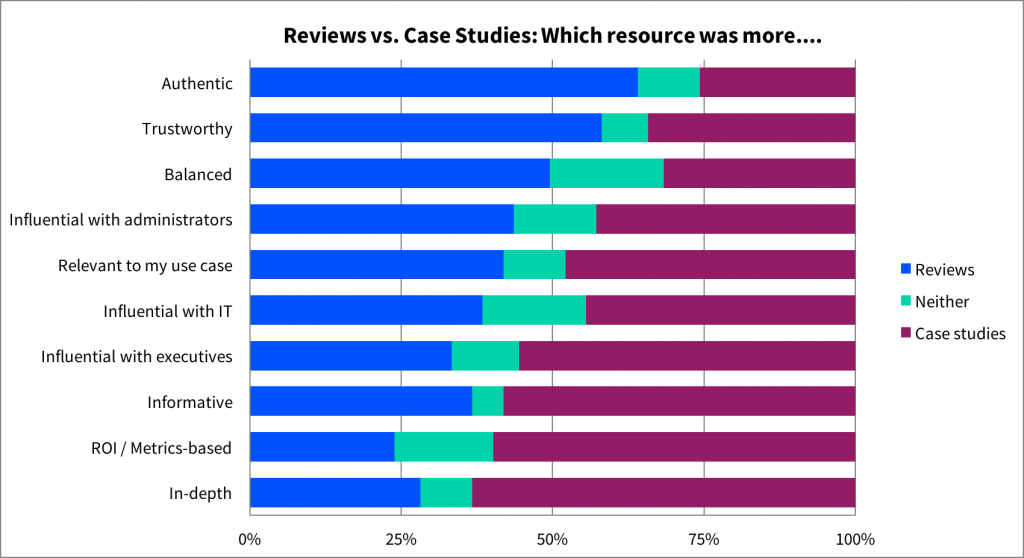
Case Studies vs. User Reviews: Frenemies or 1+1=3?
Sitting at the juncture of B2B buyers and vendors, we hear a spectrum of opinions — often contradictory — about vendor-produced case studies.
In our recent survey of TrustRadius users, some of the most vocal buyers said things like: “Case studies are all fairy tales” and “propaganda,” full of “sales spin” or even “fabricated.” Yet DemandGen’s 2017 Content Preferences Survey Report found that 78% of buyers use case studies to research B2B purchasing decisions.
In our own B2B Buying Disconnect report earlier this year, case studies were the most commonly produced content type by vendors. But while 91% vendor marketers invested in creating case studies, they found them challenging to produce, plus less effective than product demos, customer references and customer testimonials.
For many vendors, reviews have become a more efficient and more scalable way to get customers on the record. But can reviews replace case studies, or are they complementary assets for buyers? Conversely, if you already have a robust case study program, do you still need reviews?
To help vendor marketers make sense of all this, we surveyed buyers to understand how they view case studies and user reviews when researching B2B technology.
The Buyer Perspective
Both case studies and user reviews are widely used among buyers researching solutions. About 75% of our survey respondents used case studies in their research. We were surveying active buyers on our site, so all them had used reviews, but other studies have shown anywhere from 50% to 70% of B2B buyers recall consulting user reviews during the purchasing process.
Comparing Case Studies to Reviews
Most buyers think both case studies and reviews have their place in the research process, and see the two forms of social proof as serving different purposes.
In a head-to-head comparison, buyers said reviews were more authentic, trustworthy and balanced than case studies. Buyers were pretty evenly split regarding which resource was more influential with administrators, influential with IT and relevant to their use case. They thought case studies were more in-depth, metrics-based, informative and influential with executives.

Source: 2017 Survey of 250 B2B Buyers on TrustRadius.com
In qualitative responses, buyers commonly cited case studies as being comprehensive, evidence-based, and focused on the big picture. They mentioned that case studies can be useful for understanding the business problem addressed and results achieved, understanding the vendor’s positioning, and finding prime examples from the buyer’s own industry or use case.
“It is helpful to see how the vendor wants to position their products and who some customers are.”
“Helps determine the vendor’s domain expertise and experience. Helpful to know that the vendor is at some level, conversant in our industry”
“Case studies are generally more in-depth and focus more heavily on functionality and how the different functionalities help like businesses accomplish their goals.”
User reviews were cited as being authentic and unbiased, easy to consume, personal, and reflective of the real-word user experience. They were also described as impacting multiple stages of the buying process. Buyers mentioned that user reviews are useful for comparing products, finding out the positive as well as the negative parts of a product, and validating information from the vendor. (These sentiments match results from previous TrustRadius surveys.)
“[Reviews] are quicker to look through and allow you to get the opinions of more people faster.”
“Gave me a clear sense of how customers felt about service levels and interacting with the company.”
“More about user experience and adoption than in end results, helpful to know what a transition between tools might be like and what we should plan for in onboarding”
For Some Buyers, Case Studies Won’t Cut It
There is a slice of buyers that simply don’t like case studies, and the primary complaint those buyers have is bias. About a third of buyers who didn’t use case studies mentioned bias when we asked them why they didn’t use case studies. Actually, a similar percentage of buyers who did use case studies also mentioned bias when we asked how case studies compared to reviews and other forms of social proof:
“Reviews are raw opinions about a business, whereas case studies can be altered or fluffed to look better.”
“Case studies, in my opinion, lack the credibility of user reviews because the information is usually collected, compiled, and presented by the vendor themselves, and so are often inherently biased in a way that favors the vendor and not the purchaser/consumer.”
“Case studies are mostly flattering and successful. Reviews can be about good and bad experiences and more candid.”
There could be a generational component to to this trend. According to a SnapApp & Heinz Marketing study, Millennials and GenXers are half as likely as Baby Boomers to select case studies as the most effective resource when evaluating solutions. Younger generations that grew up on reviews and social networks tend to value crowd-sourced information and may be more skeptical of vendor-produced case studies.
The Benefit of Using Both
Most buyers saw a complementary relationship between user reviews and case studies. Here are some common synergies buyers described:
Reviews are easier to consume and understand whereas case studies delve into more specifics
“Reviews are crisp and short, to the point, but case studies delve deeper into specific business problem areas and how the vendor went about solving it.”
“Reviews helped me scan fairly quickly software users aligned to our business and the ratings they gave the software. So, the primary difference between reviews and case studies in my experience were the case studies offered a more thoughtful and in-depth walkthrough experience that sparked more interest and enthusiasm for the product. Reviews, on the other hand, were easier to quickly read/scan and develop a list of software applications that I might be interested in learning more about.”
Reviews provide the user perspective; case studies describe the business need and results
“Reviews are great because you get someone’s perspective on usability whereas case studies generally provide insight on how the application or software helped solve a business need(s)”
“Case studies are about how the service works, reviews tend to be more personal accounts of how the service is supported. Reviews help us understand the culture we’re about to join.”
Reviews are experiential, case studies analytical
“I started with reviews. It was good to hear both perspectives tinged with emotion (the reviews) and the analytical ones.”
“Reviews offer a real person’s direct feedback, based on their experience, not just the analytical data usually found in a case study.”
Case studies present the best case scenario, and reviews help validate
“Reviews are more trustworthy, where case studies are more about seeing what the vendor wants to position as their strengths.”
“I read comments and reviews from first hand experts and user’s opinion on how they agree or disagree to the case studies. While I would consider case studies as better reference/research material; unfiltered reviews/comments adds the trust and objectivity factor”
“Reviews are usually validations for case studies and deployment scenarios put forth by the vendor in their proposals and POCs. Real world validation is a key factor in ensuring that your investment performs as well post deployment as promised on paper.”
Case studies tell a success story; reviews provide pros, cons and lessons learned
“I use reviews as a way to find out if something is the right fit for me. Reviews are different than case studies because they tell me real world examples of what did and didn’t work for people, while a case study gives me an example of how something was done.”
“Reviews were used to figure out what the best and worst features/functionality of a product were. Case studies were more useful in a general/broad strategic sense. Reviews are more tactical and more specific.”
The Vendor Perspective
Since most buyers use both case studies and user reviews, and even play them off each other, it’s not surprising that vendors see success when they do the same.
Using Reviews to Scale Case Studies
TIBCO has an in-house program for producing video case studies and turning those videos into multiple pieces of content. They came to TrustRadius to help add scale to a critical program.
Thomas Been, CMO of TIBCO, shared his team’s recipe for success:
“First of all, when you have such a connected culture, you cannot just show up with a big new program and demand they use it. You need to build the confidence of the field. So, we started to work with a handful of AEs who trusted us and would give us access to their customers. Our goal was to have a process that was as seamless as possible for the customers — we’d have them dedicate a few hours of their time with us, we would run an interview tailored to their context but with a similar set of questions each time, ideally get that on the record as a video and then use it to drive multiple assets like blog posts, social posts, a white paper, a short video, a long video. We began with a small number of customers, delivered these assets to the organization and got the rest of the company to say they wanted more.
But everything in marketing is about scale, and this required a very high-touch approach. We wondered, is there a way we can actually scale this? In addition to capturing those great stories and using the review quotes as a form of validation, we decided to leverage TrustRadius to cast a wider net to find our champions and then build a pipeline for more in-depth success stories.”
Using Reviews to Add Authenticity
In addition to using reviews to gather customer evidence at scale, the team at Oracle leverages reviews to bring a level of authenticity to their customer advocacy efforts.
Chief Customer Officer Jeb Dasteel described the synergy between Oracle’s reviews and case studies:
“We’ve got more than 3,000 reference assets that all follow a specific standard. But we are ready for a change. Ultimately, I want more organically developed assets. I want them to be instantly relatable. Authenticity is the future, and we need to get to that future as quickly as possible. A review created by a user who has had a great experience with Oracle is increasingly critical for purchasing decisions.
The beauty of those reviews is that they are largely uncontrolled by Oracle. Well, that’s the beauty and the horror of it, right? If a customer is going to produce something, you know it will be 95% positive but perhaps 5% negative. But the power of that 95% completely counterbalances the 5% negativity. In fact, that 5% of critical feedback indicates the review is an authentic assessment of a customer’s experience. If that is the cost of telling an authentic story, I have no issue with it whatsoever.”
Bloomerang is using review quotes on case study landing pages in order to bring third-party validation to the assets directly. Kristen Hay, Marketing Coordinator at Bloomerang, said in her review of TrustRadius:
“TrustRadius has assisted us with customer outreach, creating new testimonials, and building out our reference network. We’ve been able to strengthen our case study and testimonial pages by displaying TrustRadius quotes on different pages of our website.”




